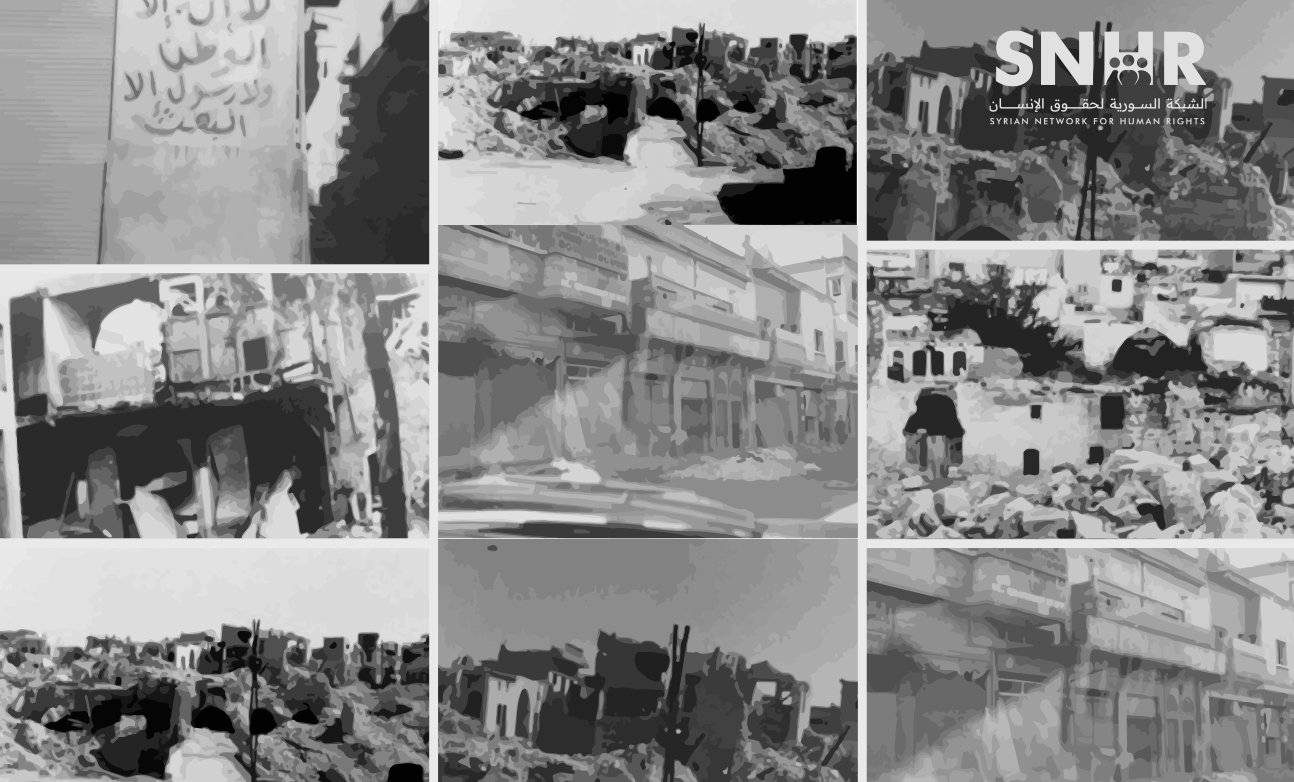Legal Recommendations and Practical Steps to Take

Available In
The Hague – The Syrian Network for Human Rights (SNHR) today released a statement entitled, ‘Delayed Justice: The Truth Must Be Uncovered and Justice Must Be Achieved for the Victims of the 1982 Hama Massacre’, outlining a set of legal and practical steps which should be taken in order to achieve justice for the victims of the infamous 1982 Hama Massacre. The statement begins by noting that December 8, 2024 marked the end of a bloody chapter in Syria’s contemporary history with the fall of the Assad regime and the assumption of power by a transitional government, ushering in the beginning of a bright new phase, one hopefully aimed at establishing justice and the rule of law for the nation. However, the statement stresses, Syria cannot build a stable future without confronting its past and ensuring justice for the former regime’s victims, foremost among them the tens of thousands of residents of Hama who, in February 1982, suffered the most horrific single massacre in the country’s modern history, in which men, women, civilians, fighters, elderly people and children alike, were killed indiscriminately in massive numbers.
As the statement further notes, for 43 years, the Hama massacre remained a taboo issue in Syria, with the Assad regime prohibiting any official investigation, accountability for the perpetrators, disclosure of the fate of thousands of forcibly disappeared persons, or even any acknowledgment of the suffering of survivors and the victims’ families. This massacre, which claimed the lives of between 30,000 and 40,000 civilians, constituted a systematically and deliberately planned collective and premeditated crime perpetrated by the Assad regime.
With the dawn of a new era in Syria, the statement underlines, it is imperative for the new Syrian government to reopen this closed file as a fundamental step in achieving justice, which can only be fully attained through ensuring accountability, reparation, the restoration of human rights, and official recognition of the massacre.
SNHR issued the first report documenting aspects of the 1982 massacre to mark its 40th anniversary in 2022. Even now, after more than 40 years, the UN has never formally documented the massacre, nor has there been any international accountability for the perpetrators. It is utterly disheartening that the international community has ignored this heinous and historic massacre for so long, and blatantly failed to uphold the victims’ and survivors’ rights. This glaring historical omission must be corrected.
In the statement, SNHR calls for putting an end to this shameful legacy of injustice left by the deposed Assad regime against Hama city and its inhabitants, as part of the process of building a state based on justice and the rule of law. In this context, the group has outlined a set of practical, legal, and national measures whose implementation is essential to achieve justice for the victims of the 1982 Hama Massacre. The transitional government and Syrian civil society must work together to implement these measures in order to ensure that such crimes are never repeated in the future.
The statement stresses that a comprehensive investigation must be opened into the Hama Massacre of 1982, which is one of the most atrocious mass crimes in Syrian history, since it was was carried out systematically over the course of an entire month by the previous Syrian regime under Hafez Assad through his security and military forces. These forces committed acts of indiscriminate killing, enforced disappearance, and systematic destruction of the city. Despite the gravity of these crimes, no official investigation has ever been conducted, and no one has been held accountable, thereby reinforcing a culture of complete impunity and enabling the continuation of similar repressive policies in the following decades, up until the fall of the regime on December 8, 2024.
The statement provides a number of key reasons that make the opening of an official investigation into the massacre an imperative necessity, including:
- The systematic nature of the massacre: The massacre was carried out as part of a widespread attack targeting civilians, in which the former regime’s military and security forces employed brutal methods such as mass killings, enforced disappearances, torture, and large-scale destruction of residential neighborhoods. This classifies it as a crime against humanity, against which there is no statute of limitations.
- Ongoing violations: The massacre included the destruction of infrastructure, the seizure of civilian property without compensation, the persecution of city residents, heightened security restrictions, and the deprivation of essential services. These actions constituted mass punishment and severe violations of international human rights and humanitarian law.
- Thousands forcibly disappeared:
- Forty-three years since February 1982, the fate of approximately 17,000 people from Hama still remains unknown ever since they were detained by Assad regime forces and transferred to secret detention centers.
- The deposed regime refused to provide any information regarding these ‘disappeared’ people’s detention or fate, making this enforced disappearance an ongoing crime.
- Reports from human rights organizations and testimonies from dozens of survivors and witnesses indicate the presence of undisclosed mass graves, necessitating the establishment of specialized investigative teams to locate these burial sites.
- Destruction and looting of civilian property without compensation
- Large parts of Hama, particularly historic neighborhoods such as al-Kilaniya, al-Asida, and al-Zanbaqi, were completely destroyed in the regime’s bombardment, with thousands of properties confiscated and repurposed into roads, parks, and government buildings without any compensation being paid to the rightful owners.
- The previous regime seized victims’ homes and businesses, awarding them to loyal security and military officers or converting them into public property, constituting a blatant violation of individual property rights.
- This violation is a clear breach of Article 17 of the Universal Declaration of Human Rights, necessitating efforts to restore these rights as part of transitional justice.
Objectives of the investigation
The statement further stresses that the investigation must be comprehensive, fair, and transparent, achieving the following objectives:
- Identify the individuals and entities responsible for the massacre
- Conduct extensive investigations into high-ranking political, military, and security leaders who may have played a role in issuing orders for the Hama Massacre, including those who were in decision-making positions at the time.
- Hold accountable all individuals who participated in mass killings, torture, arrests, and enforced disappearances, with precise documentation of their roles in order to establish their involvement, whether by issuing orders or directly executing them.
- Investigate the role played by the former regime’s military units involved in the field operations, including notorious units such as the Defense Companies, the 47th Brigade, Special Forces, and various regime intelligence agencies that may have been involved in planning or executing the massacre.
- Document all crimes and violations
- Collect material and archival evidence proving the former regime’s responsibility for the massacre, including photos, videos, documents, and weapons used, as well as any other relevant materials.
- Conduct formal interviews with survivors and victims’ families to document their testimonies accurately and systematically, contributing to the historical record and the pursuit of justice.
- Examine security and military documents left by the previous regime that may contain official orders, reports, or records indicating the planning or direct execution of the massacre.
- Uncover mass graves and ensure the dignified reburial of victims:
- Form forensic investigation teams to locate mass graves in and around Hama city.
- Exhume human remains using modern scientific methods and conduct DNA analysis to match them with the families of the victims.
- Ensure victims’ remains are returned to their families and laid to rest in a manner that respects their human dignity.
- Officially document all mass grave sites in a public report available to both Syrian and international audiences.
A national investigative commission and holding those involved to account
Moreover, the statement calls for forming a national investigative commission consisting of judges, legal experts, representatives of human rights organizations, and victims’ family members. This commission will be responsible for:
- Documenting crimes, collecting evidence and summoning witnesses.
- Analyzing security and military documents related to the massacre.
- Presenting its findings to the competent judicial authorities, along with clear recommendations regarding criminal prosecutions, compensation, and reparation to ensure justice and redress for the victims.
- Establishing a national database containing the names of victims, missing persons, and survivors.
Criminal responsibility and achieving justice
The statement also emphasizes the need to hold the responsible individuals and entities accountable, since:
- The 1982 Hama Massacre was an organized and systematic attack targeting civilians, for which those senior political, military, and security leaders involved remain directly criminally responsible.
- The list of those involved includes all those who issued orders, planned the massacre, carried it out, or covered up for the perpetrators, including Hafez Assad, Rifaat Assad, Mustafa Tlass, Adnan Assad, and senior leaders of the Assad regime’s security and military agencies.
- The principle of ‘command responsibility,’ which holds military and civilian leaders accountable for crimes committed by their subordinates if they were aware of them and failed to take measures to prevent them, applies to these individuals.
Judicial cooperation with international bodies
Additionally, the statement stresses the necessity for the national judiciary to cooperate with international bodies considering that:
- Achieving effective justice requires the engagement of the new Syrian judiciary in transparent investigations that ensure trials comply with international standards of fair trials.
- This necessitates cooperation with UN human rights agencies, such as the Office of the UN High Commissioner for Human Rights (OHCHR) and the Human Rights Council, in order to benefit from the necessary technical and legal expertise to ensure the integrity of investigations and judicial procedures.
Restoring rights and repatriation
Transitional justice, the statement further argues, is not limited to accountability, but also extends to:
- Truth-finding, property restoration, and compensating affected families.
- Establishing an independent national body to search for the missing, with broad powers including access to security and military records, searching for mass graves, and conducting DNA tests.
- Compelling the government to disclose security records related to the massacre, as well as ordering former security officials to testify about the locations of mass graves and secret detention centers.
- Granting the families of the missing the right to material and moral compensation.
Returning confiscated properties and reconstruction
- Establish a national committee for the restitution of confiscated properties, annul all confiscation decisions issued without a fair legal basis, and compensate those affected materially.
- Launch a national project to rebuild affected neighborhoods, prioritizing the return of original residents to their areas.
- Establish a national compensation fund for reconstruction, funded by the frozen assets of former regime officials, international support, and revenues from confiscated illicit assets.


